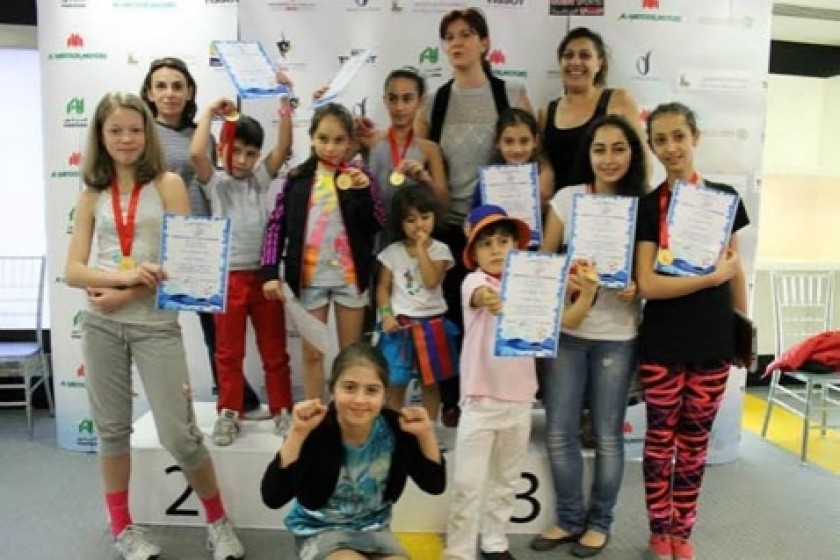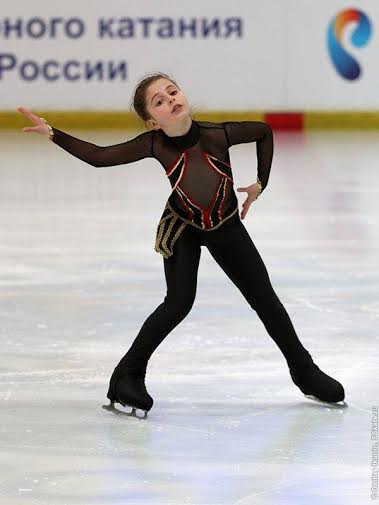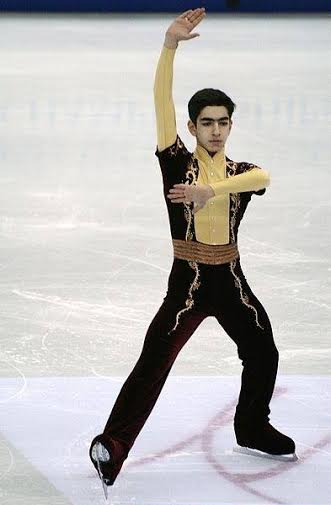
Why Doesn't Armenia Have Figure Skaters in the Sochi Winter Olympics?
Anna Babajanyan
Due to a lack of facilities and funding, professional Armenian figures are forced to train abroad and in conditions that are unequal to their counterparts in other countries — which might be part of the reason for their poor track record last month.
When Armenia's representative finished last at the 2014 European Figure Skating Championships in January in Budapest, some fans were forced to reevaluate the potential of Armenian figure skaters. When it became known that Armenia won't have a representative in the figure skating competition of the Sochi Winter Olympics, which begins today, social networking sites were buzzing with questions such as "Don't we have any good figure skaters?" and "Is figure skating as a sport neglected in Armenia?"
"We have good figure skaters. For example, we had a good contender for the Olympic Games, Arina Petrova. In order to participate in the championship, she had to be a citizen of [the Republic of] Armenia: we didn't manage to get a passport in time," explained Figure Skating Federation of Armenia President Melanya Stepanyan. "Our kids are really good. We train for two to three months, then they go to competitions, and they do well."
As for why Armenian figure skaters train only for two to three months has to do with problems that began five years ago.
Figure Skaters but No Skating Rink
The only figure skating school in Yerevan's Shengavit administrative district has been in poor condition for years. The skating rink has not been operational since 2008, and there aren't sufficient conditions to hold classes.
A professional figure skater has to train for 11 months on ice, whereas Armenian figure skaters train on ice for only 4 months — at the Karen Demirchyan Sports and Concerts Complex or the temporary skating rink at Swan Lake. So how are they able to participate in competitions and win places under these conditions?
 According to the federation's president, members of the national team and Armenia's leading figure skaters mainly train abroad. For instance, Slavik and Sargis Hayrapetyan train in Riga; Anastasia Galstyan and Izabela Davtyan, in Moscow. "In any case having our own skating rink is a necessity," she says.
According to the federation's president, members of the national team and Armenia's leading figure skaters mainly train abroad. For instance, Slavik and Sargis Hayrapetyan train in Riga; Anastasia Galstyan and Izabela Davtyan, in Moscow. "In any case having our own skating rink is a necessity," she says.
Yerevan City Hall promised to renovate the school 5 years ago, and during the Yerevan Municipal Council elections last year, the Republican Party of Armenia in its election campaign promised "to implement a program to develop figure skating and construct a corresponding sports school."
Asked by Hetq why this promise isn't being fulfilled and what steps have been taken, a Yerevan City Hall representative said that the issue of reconstructing the organization's offices and sports base is included in the annual and quarterly programs. Preparation for the first phase of reconstruction is already underway: a tender for reconstruction and drawing up the drafts of the dance choreography studios, offices, and changing rooms has been announced.
But why do athletes or coaches need changing rooms and offices if the skating rink and, to a great extent, the school won't be in operation?
As for reinstating the skating rink, the city hall representative said initially they planned to acquire a silicone rink, but later, considering experts' opinion that silicone has harmful effects, they decided to restore the rink with natural ice. This, in turn, increased the estimated amount of the project, and the need to find investors arose, for which "city hall is engaged in the relevant work."
Basically, the municipality needed the full five years to realize how dangerous silicone is. As for how many years will be required to locate investors, it's hard to say.
Armenian Figure Skaters Less Financially Secure Than Counterparts Abroad
 Not having a skating rink of our own and training abroad comes with its own set of problems. According to Stepanyan, Armenian figure skaters compared to others experience unequal competitive conditions, as training abroad requires some finances: "For example, Slavik Hayrapetyan, no matter how much he trains in Riga, has the opportunity to train [only] in the morning for two hours and that's all — he can't train for 8 hours a day like Plushenko. He's not as financially secure."
Not having a skating rink of our own and training abroad comes with its own set of problems. According to Stepanyan, Armenian figure skaters compared to others experience unequal competitive conditions, as training abroad requires some finances: "For example, Slavik Hayrapetyan, no matter how much he trains in Riga, has the opportunity to train [only] in the morning for two hours and that's all — he can't train for 8 hours a day like Plushenko. He's not as financially secure."
According to her, the 9 million AMD (about $21,964 USD) allocated to the federation annually from the state budget is not enough to cover the athletes' expenses. With this amount of money it's possible to participate in at most two international competitions. "Figure skating is an expensive sport; I barely manage to distribute the money. Participating in competitions, the current expenses, and the necessary costumes require a lot of money," Stepanyan confessed. The federation president said she doesn't stop looking for sponsors for the figure skaters.
The remaining costs are covered by individuals, mainly the athletes' parents. Figure skaters participating in international competitions abroad mostly cover their own expenses.
"No investment is made in winter sports. What do they invest in, anyway?" remarked Stepanyan, even adding that she intentionally chose a financially secure athlete to participate in an international competition once so that she "doesn't beg for money from the state."
National Olympic Committee of Armenia Has No Interest in Funding Figure Skating
To what extent is the National Olympic Committee of Armenia (NOCA) interested in financing the Figure Skating Federation of Armenia, developing figure skating as a sport in Armenia, and sponsoring athletes? By Stepanyan's account, the Olympic Committee financially assisted athletes, though she's never personally appealed to the Committee. Head of NOCA's press service Yuri Aleksanyan, in conversation with Hetq, remarked: "The Olympic Committee's president might not give a single cent at all to the Figure Skating Federation." Aleksanyan said there's no fixed amount as to how much the Committee has to give to whom.
"You want to be useful to figure skating, put down your money; if you can't, don't assume the position," he said, referring to the Figure Skating Federation of Armenia president.
Even the state, Aleksanyan said, might not finance the Federation in this case as it's a non-governmental organization. "For example, I'm the president of the country; I give money, so you can train where? If you don't have ice, I give the money, so you can take it where?" asked the National Olympic Committee of Armenia spokesperson, justifying that he's not speaking about anyone in particular.
Sport Ministry: Some Sports Federation Try to Find Sponsors on Their Own
Considering that for example, wrestling, boxing, and weightlifting get around 200 million AMD ($488,079 USD) each from the state budget annually, while figure skating gets only 9 million AMD, one is left with the impression that the state doesn't intend to develop this winter sport in Armenia.
Responding in writing to Hetq, RA Deputy Minister of Sport and Youth Affairs Nazareth Mnatsakanyan wrote: "Yes, we have great successes in some sports, especially in freestyle and Greco-Roman wrestling and sambo. Undoubtedly, maybe not a lot of money is required to develop these sports and in honor of some sports federations, they try to find sponsors on their own, who then make large financial investments."
This year, 929 million AMD ($2,267,130 USD) — 9 million of which, as previously mentioned, is for the Figure Skating Federation of Armenia — was allocated to national sports federations. Within the scope of state assistance program the amount of financing was decided according to the federations' compiled applications and plans for the year. In his response, the deputy minister did not exclude the possibility of a redistribution of financial allotments during year — by providing additional funding to federations that produce good results at the expense of those that don't. That is, based on successes this year, there would be a redistribution of the third and fourth quarters' finances.
At the end of his letter, the deputy minister made a remarkable observation: "By the way, he who wants to work, works; he who doesn't, searches for reasons…"
P.S. Beginning in 1998, Armenia participated in the figure skating competition in the Winter Olympics the same year in Japan (the pairs Maria Krasiltseva and Aleksandr Chestnikh, and Ksenia Smetanenko and Samvel Gyozalyan); in 2002, in the US (Julia Lebedeva, and the pair Maria Krasiltseva and Artem Znachkov); and in 2006, in Italy (the pair Anastasia Grebenkina and Vazgen Azrojan).
Photo credits: Figure Skating Federation of Armenia archives
 Videos
Videos Photos
Photos




Comments (1)
Write a comment